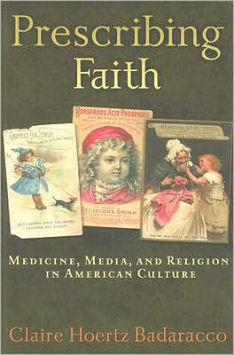
|
August 9, 2010
Book: Prescribing Faith: Medicine, Media, and Religion in American Culture Author: Claire Hoertz Badaracco Baylor University Press. Waco, TX. 2010. Pp. 264 An Excerpt from the Endorsements:
This book is a landmark account of the construction and commodification of medicine and health. Along the way, its careful historical analysis provides fascinating insights into the way ideas of faith, health, and right living have become central features of contemporary media discourse. Steward M. Hoover, Professor, School of Journalism and Mass Communication, U. Of Colorado In this hard-nosed analysis of medicine, religion, and mass media, Claire Badaracco explains the history behind today’s wholesale promotion of anxiety over health. Prescribing Faith is an engaging study that holds out hope that spirituality will serve as an antidote to relentless pharmaceutical marking. John P. Ferre, Professor of Communication, U. Of Louisville. An Excerpt from the Book: Sternberg posed the crucial question for the emerging age of scientific medical pluralism, healing through both conventional medicine and complementary approaches such as mind-body medicine, in which meditation and also prayer play a therapeutic role: “If the belief in the power of a drug to cure gives it at least a third of its ability to heal, why shouldn’t prayer and fervent belief alone be an effective cure that works in part through those same nerve pathways and hormones that traduce the placebo effect?” Only science can provide evidence about what happens within patients physiologically as they pray, but rather than get involved in what Sternberg calls the effort to “refute” or “support” its power, she concluded that the “nerve pathways and molecules that effect immune cell function activated by belief in a pill can also be activated by prayer. Koenig cited “at least sixty studies” that measured diminishment of pain and better “coping” through religious beliefs among patients with serious medical conditions such as arthritis, diabetes, kidney disease, cancer, heart disease, AIDs, sickle cell, and ALS. He related the story of one elderly patient whose religious ways of coping brought about a reduction in pain, to illustrate what happens physiologically when anxious patients pray. They become less anxious about what they cannot control, and their tense muscles relax. He used a clinical case history of one individual to help illustrate how prayer helps a patient “stop obsessing and turn things over to God,” reducing anxiety many patients feel about being ill, and their feelings of helplessness and lack of control. Table of Contents: 1. “Man’s accidents are God’s purposes” 2. Lunching a scientific religion 3. Measuring prayer 4. Belief and wellness 5. The medicated public square |
|
